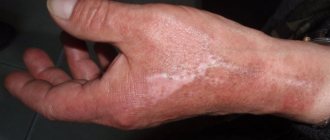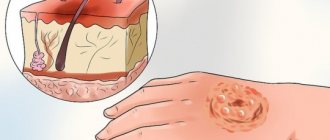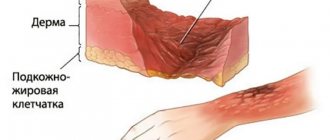Classification of burns
The severity of the injury is determined by the depth of damage to the skin. To provide effective assistance, it is necessary to correctly classify the burn:
- I degree. Slight redness of the skin area, swelling, mild pain. The consequences disappear without a trace after 3–7 days.
- II degree. Severe pain associated with the appearance of watery blisters. The deep layers of the skin are not damaged, which eliminates the formation of scars. Characterized by a change in skin color that occurs over time.
- III degree. The symptoms are many times greater than those listed above. Tissue death occurs and scabs and open wounds appear. The skin recovers poorly, forming dense scars.
- IV degree - charring. It is considered the most difficult to cure. In most cases, skin grafting is required. The injury affects the tissues of the muscles, tendons and bones.
In domestic conditions, first and second degree burns more often occur, but it is important to note that incorrectly provided or untimely assistance can lead to infection of the damaged area and serious consequences even with a second degree burn. If you are injured, it is important to see a doctor as soon as possible.
Remedy for burns - we act quickly and correctly
The most important structural component of cells is proteins. Their “representatives” collagen and keratin provide physical protection to the body by forming a structural framework that maintains the shape of cells. At temperatures above 44 degrees, proteins lose their three-dimensional shape and are destroyed. This leads to damage to cells and tissues, which occurs with any, even the mildest burn.
Depending on the depth of the injury, there are several degrees of severity of the burn.
First degree burns
the most innocent ones. With them, only the upper, keratinized layer of the epidermis is damaged. Manifested by redness, pain and slight swelling. After a few days, not a trace remains of them.
Second degree burns
characterized by damage to the epidermis to the deeper, germinal layer. Lymph and, less commonly, blood from destroyed cells penetrate upward, forming blisters. These burns heal after 1–3 weeks.
For third degree burns
not only all layers of the epidermis are affected, but also the underlying dermis, in severe cases down to the subcutaneous fatty tissue. The third degree is characterized by large blisters, which often open to reveal dense white or brown tissue.
First aid for thermal burns
The basic rule of providing care for burns before being examined by a doctor is to do no harm! What to do:
- Don't panic!
- Provide the victim with a safe place, removing the cause of the injury.
- If the burn is caused by hot liquid, it is important to remove hot, wet clothing as soon as possible. If the fabric is stuck to the skin, carefully cut it with scissors; do not remove the stuck fragments yourself.
- Reduce the temperature of damaged tissues. Immediately after receiving a first or second degree burn, the injured area must be cooled with running water; in more serious cases, a cool bath or a damp sterile bandage can be used.
- If the pain is severe, take a painkiller.
Causes of chemical burns
Chemical burns can occur at work, at home, or during suicide attempts. They occur when exposed to the following substances:
- acids (sulfuric, hydrofluoric, hydrochloric, acetic, nitric, etc.);
- alkalis (caustic soda, etc.);
- petrol;
- phosphorus;
- kerosene;
- bitumen;
- salts of heavy metals (zinc chloride, silver nitrate), etc.
The insidiousness of chemical burns lies in the fact that tissue damage occurs before the substance is completely neutralized and eliminated. In this case, acid burns are more favorable, since upon their contact with tissue proteins, a scab is formed, preventing further penetration of acids. Alkalis, unfortunately, have a fat-dissolving effect, so they cause deep burns. Phosphorus causes not only serious local tissue damage, but also severe general poisoning.
Treatment
Intensive treatment of any type of burn of the cornea begins immediately after the patient enters a medical facility. To begin with, instillation of scopolamine and atropine directly into the eye is prescribed. These drugs relieve pain and reduce the formation of adhesions between the cornea and conjunctiva.
On the first day, the process of tissue change under the influence of traumatic factors continues. It is impossible to stop it completely, so doctors will have to wait until the necrotic processes stabilize. At this stage, it is important to prevent infection of the eyeball and reduce the intensity of symptoms. For this use:
- ointments and drops
with tetracycline, ciprofloxacin or chloramphenicol; - local non-steroidal anti-inflammatory drugs
- Diclofenac or Ibuprofen; - substitutes for tear fluid
to prevent drying of the cornea.
After stabilization of the condition, rehabilitation treatment begins. In the absence of perforations of the membranes of the eye, conservative methods are limited:
- injections of antioxidant drugs (methylethylpyridinol);
- placing gel-like regenerating preparations (Solcoseryl or Deskpanthenol) behind the eyelid;
- instillation of antihypertensive solutions (Betaxolol or Dorzolamide) into the eyes.
If the corneal burn is deep, hormonal agents are prescribed, most often glucocorticoids in the form of solutions for injection into the eyeball or conjunctiva.
Surgical intervention is used for deep and widespread damage to the membranes and internal structures of the eye.
If the anterior chamber of the eye is affected, corneal paracentesis is performed, followed by chamber sanitation. In case of deep damage to the eyeball, the dead areas of the conjunctiva, cornea, and vitreous body are removed, after which plastic restoration of the removed tissue is carried out.
In the long-term period, patients may require plastic restoration of the eyelids: elimination of eversion and entropion, ptosis, trichiasis, correction of post-burn cataracts, lamellar keratoplasty, etc.
How dangerous are burns?
First and second degree burns, as a rule, do not pose a significant danger to human health - especially if they are not extensive.
Injuries of the third and especially fourth degrees, without taking appropriate measures, can cause severe intoxication of the body, the cause of which is overload of the liver and kidneys due to the removal of decay products of damaged tissues.
The body's immune defense is disrupted, making it easily susceptible to infections.
Both of these factors lead to exhaustion of the body, and then to death.
Types of oral burns
A burn is a very common injury. Along with the oral cavity, the larynx and esophagus may be affected. There are four main forms of burns:
- Thermal burn. Occurs through contact of the oral cavity with hot liquid or steam.
- Electrical injury. The most common case of such an injury is a violation of the rules for conducting physiotherapeutic procedures.
- Chemical burn. This injury occurs as a result of contact of the oral mucosa with acids, alkalis or chlorine.
- Radiation burn. You can get such a burn during radiation therapy in the complex treatment of malignant neoplasms of the larynx.
Symptoms
Clinically, a corneal burn always manifests itself clearly and unambiguously: even without special knowledge, it is difficult to mistake it for another injury. The most striking symptoms of chemical and thermal burns are:
- acute, almost unbearable pain localized in the damaged eye and eyelid;
- reflex closure of the eyelids, photophobia;
- intense lacrimation (if the tear ducts are damaged, the sign may be absent);
- hyperemia of the skin, mucous membranes, conjunctiva;
- clouding of the cornea (noticeable with a severe burn).
Radiation damage may not be accompanied by unpleasant symptoms immediately after receiving it. Burning sensation, lacrimation, photophobia, hyperemia and photophobia appear after a few hours.
First aid
According to statistics, the degree and depth of damage to the cornea is influenced not by the type of traumatic impact, but by the duration of its contact with the surface of the eye. That is why everyone, without exception, needs to know basic first aid measures.
Important! A quick and correct reaction is especially important in cases where there is a thermal or chemical burn to the cornea of the eye.
What needs to be done to stop or reduce the influence of traumatic factors
:
- rinse the eye with a stream of cool, clean water, preferably saline, but regular tap water will do;
- remove foreign bodies from the surface of the eye, especially if they are hot metal particles (molten polymers should not be touched);
- Place a gel or ointment with an analgesic effect in the conjunctival sac to relieve pain and prevent the development of shock.
In the first hours after the patient’s admission to the hospital, doctors must rinse the lacrimal canals and remove foreign bodies embedded in the membrane of the eye. To prevent infection, chemically neutral antiseptic solutions are used to wash the eye.
Important! It is strictly forbidden to wash off chemical reagents from the surface of the eye with other chemicals, for example, acids and alkalis and vice versa, as this can lead to additional damage. Experts note that treating a combined corneal burn is many times more difficult than a specific type of burn.
Symptoms and diagnosis of chemical burns
The symptoms of burns are related to the chemical nature, concentration, quantity, duration of the damaging effect of the substance and the location of the injury. The burned person experiences intense pain in the affected area. Burns of the pharynx or esophagus are accompanied by difficulty swallowing. In case of severe chemical burns, general symptoms are observed (fever, disturbances of consciousness, etc.), and burn shock may develop.
The severity of the lesion is determined during a medical examination:
- 1st degree – swelling and redness of the burned area are characteristic;
- 2nd degree - bubbles filled with liquid appear in the affected area. 2nd degree burns are superficial and heal quickly, because epithelization (healing) occurs over the entire wound surface;
- 3rd degree - the appearance of tissue necrosis (necrosis) - refers to deep burns. Such burns can take a long time to heal, because... the wound surface is epithelized only from the edges.
The photo above shows a chemical burn caused by improper use of dimexide. The exfoliated epidermis is partially excised, and the wound surface is visible underneath.
The same burn after treatment 5 days later - the wound has almost healed.
Deep burns are fraught with the subsequent formation of rough, disfiguring scars.
In some cases, the type of damaging agent can be determined by the smell and color of the scab. Thus, when tissue comes into contact with sulfuric acid, a black scab is formed, when interacting with nitric acid it is yellow, and when exposed to acetic acid it is white. It is quite dry, dense and clearly demarcated. In the case of alkali burns, the whitish scab has a soft, friable consistency and blurred boundaries. After a phosphorus burn, a dry scab remains, glowing when darkened. The crust that forms after contact with molten bitumen is difficult to remove.
To clarify the origin of the damaging agent, samples of tissue, vomit, and saliva can be sent for examination within 2 days after the injury.











